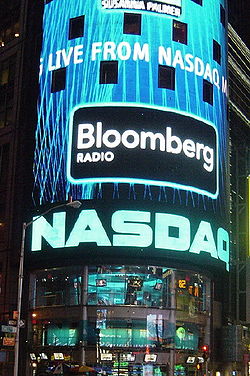Nasdaq
| NASDAQ Logo | |
| Company type | Public (Nasdaq: NDAQ) |
|---|---|
| Founded | February 8, 1971 |
| Headquarters | , |
Key people | Robert Greifeld, CEO[1]
David P. Warren, CFO Anna M. Ewing, CIO |
| Website | www.nasdaq.com |


The NASDAQ (acronym National Association of Securities Dealers Automated Quotations system) is an American stock market. It was founded in 1971 by the National Association of Securities Dealers (NASD), who divested it in a series of sales in 2000 and 2001. It is owned and operated by The Nasdaq Stock Market, Inc. the stock of which was listed on its own stock exchange in 2002. NASDAQ is the largest electronic screen-based equity securities market in the United States. With approximately 3,200 companies, it lists more companies and on average trades more shares per day than any other U.S. market.[2]
History
When it began trading on February 8, 1971, it was the world's first electronic stock market. At first, it was merely a computer bulletin board system and did not actually connect buyers and sellers. The NASDAQ helped lower the spread (the difference between the bid price and the ask price of the stock) but somewhat paradoxically was unpopular among brokerages because they made much of their money on the spread. Over the years, NASDAQ became more of a stock market by adding trade and volume reporting and automated trading systems. NASDAQ was also the first stock market to advertise to the general public, highlighting NASDAQ-traded companies (usually in technology) and closing with the declaration that NASDAQ is "the stock market for the next hundred years." Its main index is the NASDAQ Composite, which has been published since its inception. However, its exchange-traded fund tracks the large-cap NASDAQ 100 index, which was introduced in 1985 alongside the NASDAQ 100 Financial Index.
Until 1987, most trading occurred via the telephone, but during the October 1987 stock market crash, market makers often didn't answer their phones. To counteract this, the Small Order Execution System (SOES) was established, which provides an electronic method for dealers to enter their trades. NASDAQ requires market makers to honor trades over SOES.[3]
Business
NASDAQ allows multiple market participants to trade through its Electronic Communication Networks (ECNs) structure, increasing competition. The Small Order Execution System (SOES) is another NASDAQ feature, introduced in 1987, to ensure that in 'turbulent' market conditions small market orders are not forgotten but are automatically processed. With approximately 3,200 companies, it lists more companies and, on average, its systems trade more shares per day than any other stock exchange in the world. NASDAQ will follow the New York Stock Exchange in halting domestic trading in the event of a sharp and sudden decline of the Dow Jones Industrial Average. [4]
In business, Nasdaq is often used as a non-acronym also.
Market Share
As of 1 March 2007, NASDAQ is the largest Electronic Communication Network system in terms of shares traded. Approximately two out of every seven shares traded on the American financial markets is traded on the system. For New York Stock Exchange-listed securities or Tape A, it accounts for about 14-15% of the shares traded. For Tape C securities, it accounts for approximately 45-98% of the trading volume. [5]
Fees
NASDAQ has a sliding fee system that offers lower liquidity removal fees and more favorable added-liquidity rebates based on how much trading volume the market participant executes on the NASDAQ system.
Quote availability
NASDAQ quotes are available at three levels. Level I shows the highest bid and lowest offer — the inside quote. Level II shows all public quotes of market makers together with information of market makers wishing to sell or buy stock and recently executed orders. Level III is used by the market makers and allows them to enter their quotes and execute orders.[6]
Indices
Markets
See also
References
- ^ "FACTSHEET 2007" (PDF). NASDAQ Newsroom. The Nasdaq Stock Market. 2007. Retrieved 2007-05-29.
{{cite web}}: Check date values in:|date=(help) - ^ "NASDAQ Performance Report". NASDAQ Newsroom. The Nasdaq Stock Market. 2007-01-12. Retrieved 2007-02-15.
{{cite web}}: Check date values in:|date=(help) - ^ Wells, Rob. "'Market for Next 100 Years' is 25". Associated Press.
- ^ "Circuit Breaker Trigger Points and Trade Halt Durations".
- ^ "Market Volume Summary".
- ^ "Nasdaq Level I, Level II , Level III Quotes".
